Docking Proteins Upregulate IL-1β Expression in Lower Esophageal Sphincter Muscle in Esophageal Achalasia
Abstract
1. Introduction
2. Materials and Methods
2.1. Ethical Considerations
2.2. Peroral Endoscopic Muscular Biopsy Sampling during Peroral Endoscopic Myotomy (POEM)
2.3. RT-qPCR
2.4. miRNA Array Hybridization and Analysis
2.5. Statistical Analysis
3. Results
4. Discussion
5. Conclusions
Author Contributions
Funding
Institutional Review Board Statement
Informed Consent Statement
Data Availability Statement
Conflicts of Interest
References
- Kanda, T.; Yoshida, A.; Ogihara, K.; Minami, H.; Yamaguchi, N.; Ikebuchi, Y.; Nakao, K.; Isomoto, H. Detection of Cytokine Storm in Patients with Achalasia Using ELISA. Biomed. Rep. 2021, 15, 62. [Google Scholar] [CrossRef] [PubMed]
- Kahrilas, P.J.; Boeckxstaens, G. The Spectrum of Achalasia: Lessons from Studies of Pathophysiology and High-Resolution Manometry. Gastroenterology 2013, 145, 954–965. [Google Scholar] [CrossRef] [PubMed]
- Minami, H.; Isomoto, H.; Miuma, S.; Kobayashi, Y.; Yamaguchi, N.; Urabe, S.; Matsushima, K.; Akazawa, Y.; Ohnita, K.; Takeshima, F.; et al. New Endoscopic Indicator of Esophageal Achalasia: “Pinstripe Pattern”. PLoS ONE 2015, 10, e0101833. [Google Scholar] [CrossRef]
- Furuzawa-Carballeda, J.; Torres-Landa, S.; Valdovinos, M.Á.; Coss-Adame, E.; Martín Del Campo, L.A.M.; Torres-Villalobos, G. New Insights into the Pathophysiology of Achalasia and Implications for Future Treatment. World J. Gastroenterol. 2016, 22, 7892–7907. [Google Scholar] [CrossRef] [PubMed]
- Ghoshal, U.C.; Daschakraborty, S.B.; Singh, R. Pathogenesis of Achalasia Cardia. World J. Gastroenterol. 2012, 18, 3050–3057. [Google Scholar] [CrossRef]
- Pressman, A.; Behar, J. Etiology and Pathogenesis of Idiopathic Achalasia. J. Clin. Gastroenterol. 2017, 51, 195–202. [Google Scholar] [CrossRef]
- Furuzawa-Carballeda, J.; Aguilar-León, D.; Gamboa-Domínguez, A.; Valdovinos, M.A.; Nuñez-Álvarez, C.; Martín-Del-Campo, L.A.; Enríquez, A.B.; Coss-Adame, E.; Svarch, A.E.; Flores-Nájera, A.; et al. Achalasia—An Autoimmune Inflammatory Disease: A Cross-Sectional Study. J. Immunol. Res. 2015, 2015, 729217. [Google Scholar] [CrossRef] [PubMed]
- Piedade, D.; Azevedo-Pereira, J.M. The Role of MicroRNAs in the Pathogenesis of Herpesvirus Infection. Viruses 2016, 8, 156. [Google Scholar] [CrossRef]
- Cokarić Brdovčak, M.; Zubković, A.; Jurak, I. Herpes Simplex Virus 1 Deregulation of Host MicroRNAs. Noncoding RNA 2018, 4, 36. [Google Scholar] [CrossRef]
- Zheng, K.; Liu, Q.; Wang, S.; Ren, Z.; Kitazato, K.; Yang, D.; Wang, Y. HSV-1-Encoded MicroRNA MiR-H1 Targets Ubr1 to Promote Accumulation of Neurodegeneration-Associated Protein. Virus Genes 2018, 54, 343–350. [Google Scholar] [CrossRef]
- Bernier, A.; Sagan, S.M. The Diverse Roles of MicroRNAs at the Host–Virus Interface. Viruses 2018, 10, 440. [Google Scholar] [CrossRef] [PubMed]
- Lahmidi, S.; Yousefi, M.; Dridi, S.; Duplay, P.; Pearson, A. Dok-1 and Dok-2 Are Required to Maintain Herpes Simplex Virus 1-Specific CD8+ T Cells in a Murine Model of Ocular Infection. J. Virol. 2017, 91, e02297-16. [Google Scholar] [CrossRef] [PubMed]
- Besin, G.; Yousefi, M.; Saba, I.; Klinck, R.; Pandolfi, P.P.; Duplay, P. Dok-1 Overexpression Promotes Development of Γδ Natural Killer T Cells. Eur. J. Immunol. 2012, 42, 2491–2504. [Google Scholar] [CrossRef]
- Gugasyan, R.; Quilici, C.; I, S.T.; Grail, D.; Verhagen, A.M.; Roberts, A.; Kitamura, T.; Dunn, A.R.; Lock, P. Dok-Related Protein Negatively Regulates T Cell Development via Its RasGTPase-Activating Protein and Nck Docking Sites. J. Cell Biol. 2002, 158, 115–125. [Google Scholar] [CrossRef] [PubMed]
- Laroche-Lefebvre, C.; Yousefi, M.; Daudelin, J.-F.; Charpentier, T.; Tarrab, E.; Klinck, R.; Lamarre, A.; Labrecque, N.; Stäger, S.; Duplay, P. Dok-1 and Dok-2 Regulate the Formation of Memory CD8+ T Cells. J. Immunol. 2016, 197, 3618–3627. [Google Scholar] [CrossRef]
- Inoue, H.; Shiwaku, H.; Iwakiri, K.; Onimaru, M.; Kobayashi, Y.; Minami, H.; Sato, H.; Kitano, S.; Iwakiri, R.; Omura, N.; et al. Clinical Practice Guidelines for Peroral Endoscopic Myotomy. Dig. Endosc. 2018, 30, 563–579. [Google Scholar] [CrossRef]
- Japan Esophageal Society. Descriptive Rules for Achalasia of the Esophagus, June 2012: 4th Edition. Esophagus 2017, 14, 275–289. [Google Scholar] [CrossRef]
- Sato, H.; Inoue, H.; Ikeda, H.; Sato, C.; Santi, E.G.R.; Phalanusitthepha, C.; Aoyagi, Y.; Kudo, S.E. In Vivo Histopathological Assessment of the Muscularis Propria in Achalasia by Using Endocytoscopy (with Video). Endosc. Int. Open 2014, 2, E178–E182. [Google Scholar] [CrossRef][Green Version]
- Nakajima, N.; Sato, H.; Takahashi, K.; Hasegawa, G.; Mizuno, K.; Hashimoto, S.; Sato, Y.; Terai, S. Muscle Layer Histopathology and Manometry Pattern of Primary Esophageal Motility Disorders Including Achalasia. Neurogastroenterol. Motil. 2017, 29, e12968. [Google Scholar] [CrossRef]
- Lee, J.; Kim, H.R.; Quinley, C.; Kim, J.; Gonzalez-Navajas, J.; Xavier, R.; Raz, E. Autophagy Suppresses Interleukin-1β (IL-1β) Signaling by Activation of p62 Degradation via Lysosomal and Proteasomal Pathways. J. Biol. Chem. 2012, 287, 4033–4040. [Google Scholar] [CrossRef]
- Choe, J.Y.; Jung, H.Y.; Park, K.Y.; Kim, S.K. Enhanced p62 Expression Through Impaired Proteasomal Degradation Is Involved in Caspase-1 Activation in Monosodium Urate Crystal-Induced Interleukin-1β Expression. Rheumatology 2014, 53, 1043–1053. [Google Scholar] [CrossRef]
- Saitoh, T.; Fujita, N.; Jang, M.H.; Uematsu, S.; Yang, B.G.; Satoh, T.; Omori, H.; Noda, T.; Yamamoto, N.; Komatsu, M.; et al. Loss of the Autophagy Protein Atg16L1 Enhances Endotoxin-Induced IL-1β Production. Nature 2008, 456, 264–268. [Google Scholar] [CrossRef]
- Lassen, K.G.; Kuballa, P.; Conway, K.L.; Patel, K.K.; Becker, C.E.; Peloquin, J.M.; Villablanca, E.J.; Norman, J.M.; Liu, T.C.; Heath, R.J.; et al. Atg16L1 T300A Variant Decreases Selective Autophagy Resulting in Altered Cytokine Signaling and Decreased Antibacterial Defense. Proc. Natl. Acad. Sci. USA 2014, 111, 7741–7746. [Google Scholar] [CrossRef]
- Saitoh, T.; Akira, S. Regulation of Inflammasomes by Autophagy. J. Allergy Clin. Immunol. 2016, 138, 28–36. [Google Scholar] [CrossRef] [PubMed]
- Khajanchee, Y.S.; VanAndel, R.; Jobe, B.A.; Barra, M.J.; Hansen, P.D.; Swanstrom, L.L. Electrical Stimulation of the Vagus Nerve Restores Motility in an Animal Model of Achalasia. J. Gastrointest. Surg. 2003, 7, 843–849. [Google Scholar] [CrossRef] [PubMed]
- Satchell, P.M.; Mcleod, J.G.; Harper, B.; Goodman, A.H. Abnormalities in the Vagus Nerve in Canine Acrylamide Neuropathy. J. Neurol. Neurosurg. Psychiatry 1982, 45, 609–619. [Google Scholar] [CrossRef]
- Pang, J.; Borjeson, T.M.; Muthupalani, S.; Ducore, R.M.; Carr, C.A.; Feng, Y.; Sullivan, M.P.; Cristofaro, V.; Luo, J.; Lindstrom, J.M.; et al. Megaesophagus in a Line of Transgenic Rats: A Model of Achalasia. Vet. Pathol. 2014, 51, 1187–1200. [Google Scholar] [CrossRef] [PubMed]
- Sabirov, A.G.; Raginov, I.S.; Burmistrov, M.V.; Chelyshev, Y.A.; Khasanov, R.S.; Moroshek, A.A.; Grigoriev, P.N.; Zefirov, A.L.; Mukhamedyarov, M.A. Morphofunctional Analysis of Experimental Model of Esophageal Achalasia in Rats. Bull. Exp. Biol. Med. 2010, 149, 466–470. [Google Scholar] [CrossRef]
- Febrônio, L.H.P.; Britto-Garcia, S.; de Oliveira, J.S.M.; Zucoloto, S. Megaesophagus in Rats. Res. Exp. Med. 1997, 197, 109–115. [Google Scholar] [CrossRef]
- Singaram, C.; Sweet, M.A.; Gaumnitz, E.A.; Bass, P.; Snipes, R.L. Evaluation of Early Events in the Creation of Amyenteric Opossum Model of Achalasia. Neurogastroenterol. Motil. 1996, 8, 351–361. [Google Scholar] [CrossRef]
- Gaumnitz, E.A.; Bass, P.; Osinski, M.A.; Sweet, M.A.; Singaram, C. Electrophysiological and Pharmacological Responses of Chronically Denervated Lower Esophageal Sphincter of the Opossum. Gastroenterology 1995, 109, 789–799. [Google Scholar] [CrossRef]
- van der Weyden, L.; Happerfield, L.; Arends, M.J.; Adams, D.J. Megaoesophagus in Rassf1a-Null Mice. Int. J. Exp. Pathol. 2009, 90, 101–108. [Google Scholar] [CrossRef] [PubMed]
- Huebner, A.; Mann, P.; Rohde, E.; Kaindl, A.M.; Witt, M.; Verkade, P.; Jakubiczka, S.; Menschikowski, M.; Stoltenburg-Didinger, G.; Koehler, K. Mice Lacking the Nuclear Pore Complex Protein ALADIN Show Female Infertility but Fail to Develop a Phenotype Resembling Human Triple A Syndrome. Mol. Cell. Biol. 2006, 26, 1879–1887. [Google Scholar] [CrossRef] [PubMed]
- BenMohamed, L.; Osorio, N.; Srivastava, R.; Khan, A.A.; Simpson, J.L.; Wechsler, S.L. Decreased Reactivation of a Herpes Simplex Virus Type 1 (HSV-1) Latency-Associated Transcript (LAT) Mutant Using the In Vivo Mouse UV-B Model of Induced Reactivation. J. Neurovirol. 2015, 21, 508–517. [Google Scholar] [CrossRef] [PubMed][Green Version]
- Dweikat, S.N.; Renner, D.W.; Bowen, C.D.; Szpara, M.L. Multi-phenotype Analysis for Enhanced Classification of 11 Herpes Simplex Virus 1 Strains. J. Gen. Virol. 2022, 103, 001780. [Google Scholar] [CrossRef] [PubMed]
- Minagawa, H.; Yanagi, Y. Latent Herpes Simplex virus-1 Infection in SCID Mice Transferred with Immune CD4+T Cells: A New Model for Latency. Arch. Virol. 2000, 145, 2259–2272. [Google Scholar] [CrossRef] [PubMed]
- Paul, S.; Khanapur, S.; Boersma, W.; Sijbesma, J.W.; Ishiwata, K.; Elsinga, P.H.; Meerlo, P.; Doorduin, J.; Dierckx, R.A.; van Waarde, A. Cerebral Adenosine A1 Receptors Are Upregulated in Rodent Encephalitis. NeuroImage 2014, 92, 83–89. [Google Scholar] [CrossRef] [PubMed]
- Matsuzono, K.; Kim, Y.; Honda, H.; Anan, Y.; Tsunoda, M.; Amano, Y.; Fukusima, N.; Iwaki, T.; Kitamoto, T.; Fujimoto, S. Prion Gene PRNP Y162X Truncation Mutation Can Induce a Refractory Esophageal Achalasia. Am. J. Gastroenterol. 2021, 116, 1350–1351. [Google Scholar] [CrossRef] [PubMed]
- Pühringer, M.; Eisenkölbl, A.; Gröppel, G. Expanding the Phenotype of RBCK1-Associated Polyglucosan Body Myopathy Type 1. Mol. Genet. Metab. Rep. 2024, 38, 101031. [Google Scholar] [CrossRef]
- Li, Q.; Chen, W.; Wang, C.; Liu, Z.; Gu, Y.; Xu, X.; Xu, J.; Jiang, T.; Xu, M.; Wang, Y.; et al. Whole-Exome Sequencing Reveals Common and Rare Variants in Immunologic and Neurological Genes Implicated in Achalasia. Am. J. Hum. Genet. 2021, 108, 1478–1487. [Google Scholar] [CrossRef]
- Sharina, I.; Lezgyieva, K.; Krutsenko, Y.; Martin, E. Higher Susceptibility to Heme Oxidation and Lower Protein Stability of the Rare α1C517Yβ1 sGC Variant Associated with Moyamoya Syndrome. Biochem. Pharmacol. 2021, 186, 114459. [Google Scholar] [CrossRef] [PubMed]
- Furuzawa-Carballeda, J.; Zuñiga, J.; Hernández-Zaragoza, D.I.; Barquera, R.; Marques-García, E.; Jiménez-Alvarez, L.; Cruz-Lagunas, A.; Ramírez, G.; Regino, N.E.; Espinosa-Soto, R.; et al. An original Eurasian haplotype, HLA-DRB1*14:54-DQB1*05:03, influences the susceptibility to idiopathic achalasia. PLoS ONE 2018, 13, e0201676. [Google Scholar] [CrossRef] [PubMed]
- Maharaj, A.; Maudhoo, A.; Chan, L.F.; Novoselova, T.; Prasad, R.; Metherell, L.A.; Guasti, L. Isolated Glucocorticoid Deficiency: Genetic Causes and Animal Models. J. Steroid Biochem. Mol. Biol. 2019, 189, 73–80. [Google Scholar] [CrossRef] [PubMed]
- Nelson, M.; Zhang, X.; Pan, Z.; Spechler, S.J.; Souza, R.F. Mast Cell Effects on Esophageal Smooth Muscle and Their Potential Role in Eosinophilic Esophagitis and Achalasia. Am. J. Physiol. Gastrointest. Liver Physiol. 2021, 320, G319–G327. [Google Scholar] [CrossRef] [PubMed]
- Takahashi, T. Pathophysiological Significance of Neuronal Nitric Oxide Synthase in the Gastrointestinal Tract. J. Gastroenterol. 2003, 38, 421–430. [Google Scholar] [CrossRef]
- Mazzanti, B.; Lorenzi, B.; Lorenzoni, P.; Borghini, A.; Boieri, M.; Lorenzi, M.; Santosuosso, M.; Bosi, A.; Saccardi, R.; Weber, E.; et al. Treatment of Experimental Esophagogastric Myotomy with Bone Marrow Mesenchymal Stem Cells in a Rat Model. Neurogastroenterol. Motil. 2013, 25, e669–e679. [Google Scholar] [CrossRef]
Disclaimer/Publisher’s Note: The statements, opinions, and data contained in all publications are solely those of the individual author(s) and contributor(s) and not of the MDPI and/or editor(s). MDPI and/or the editor(s) disclaim responsibility for any injury to people or property resulting from any ideas, methods, instructions, or products referred to in the content. |
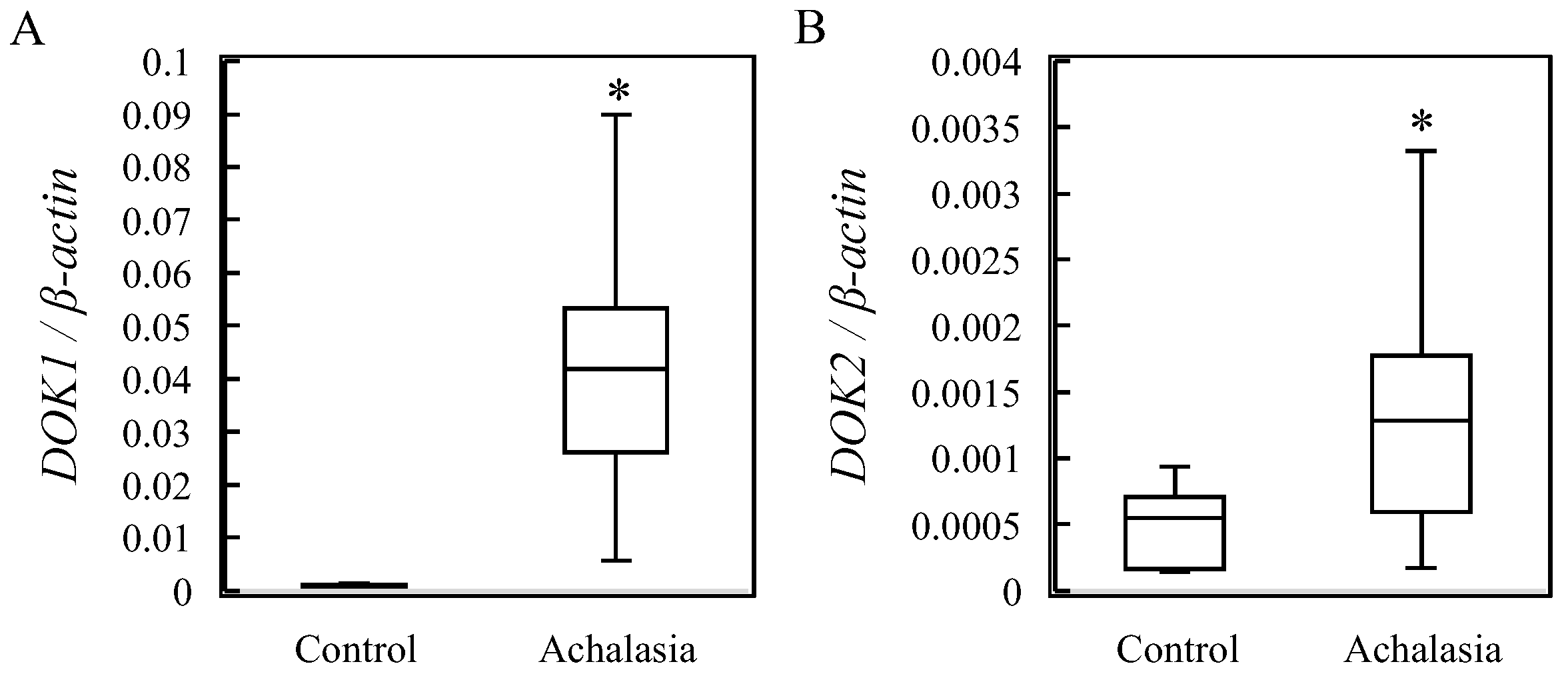
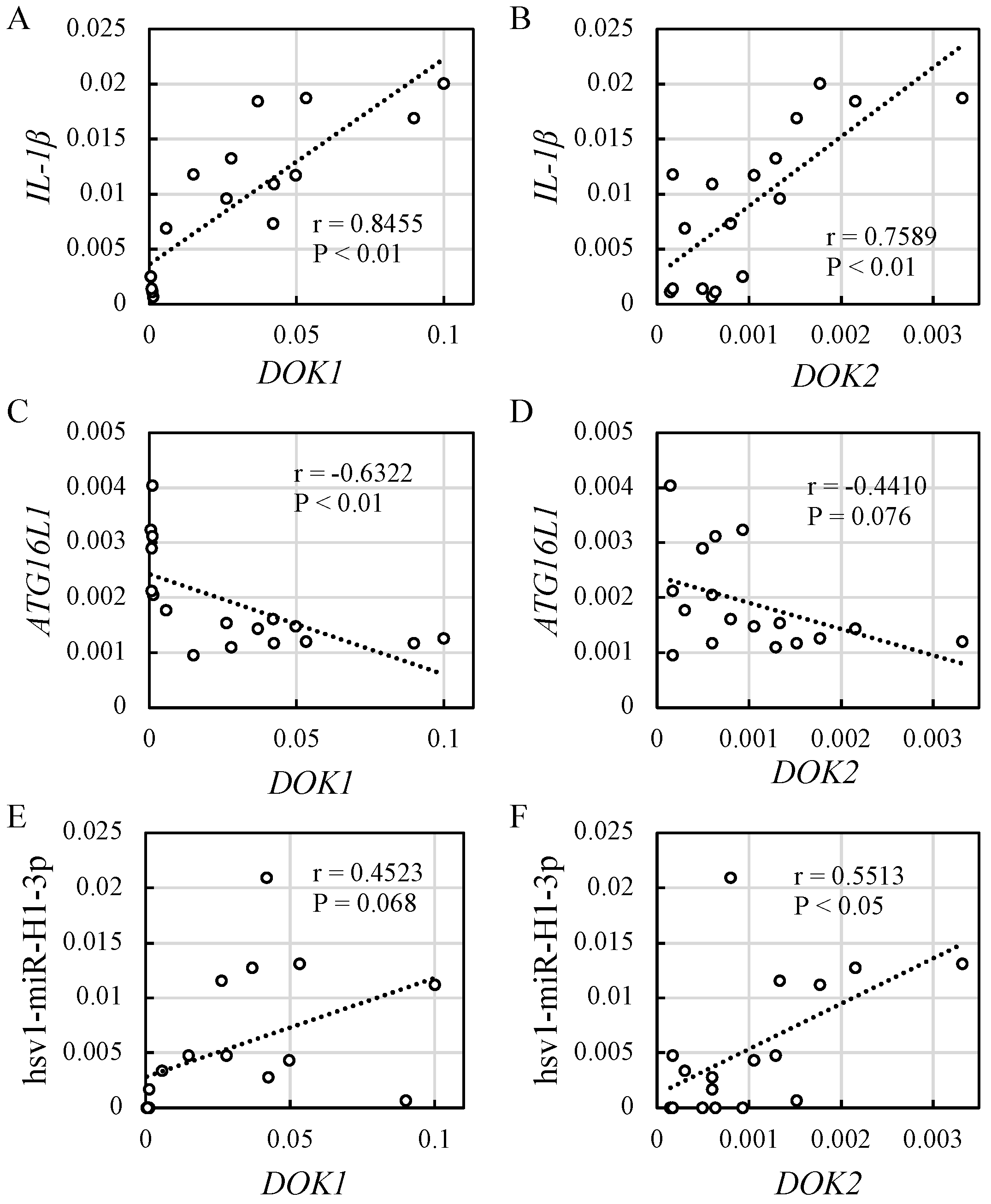

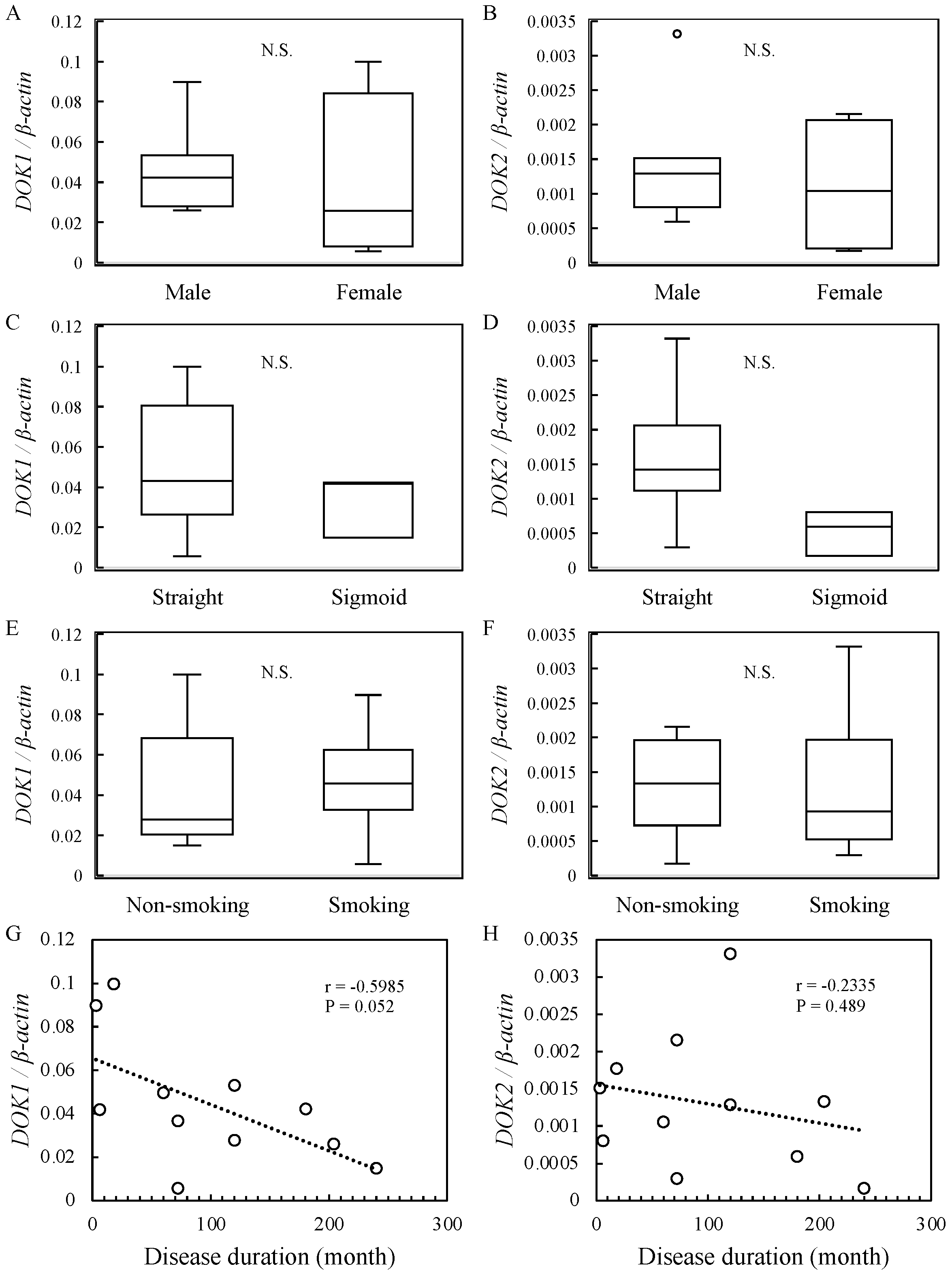
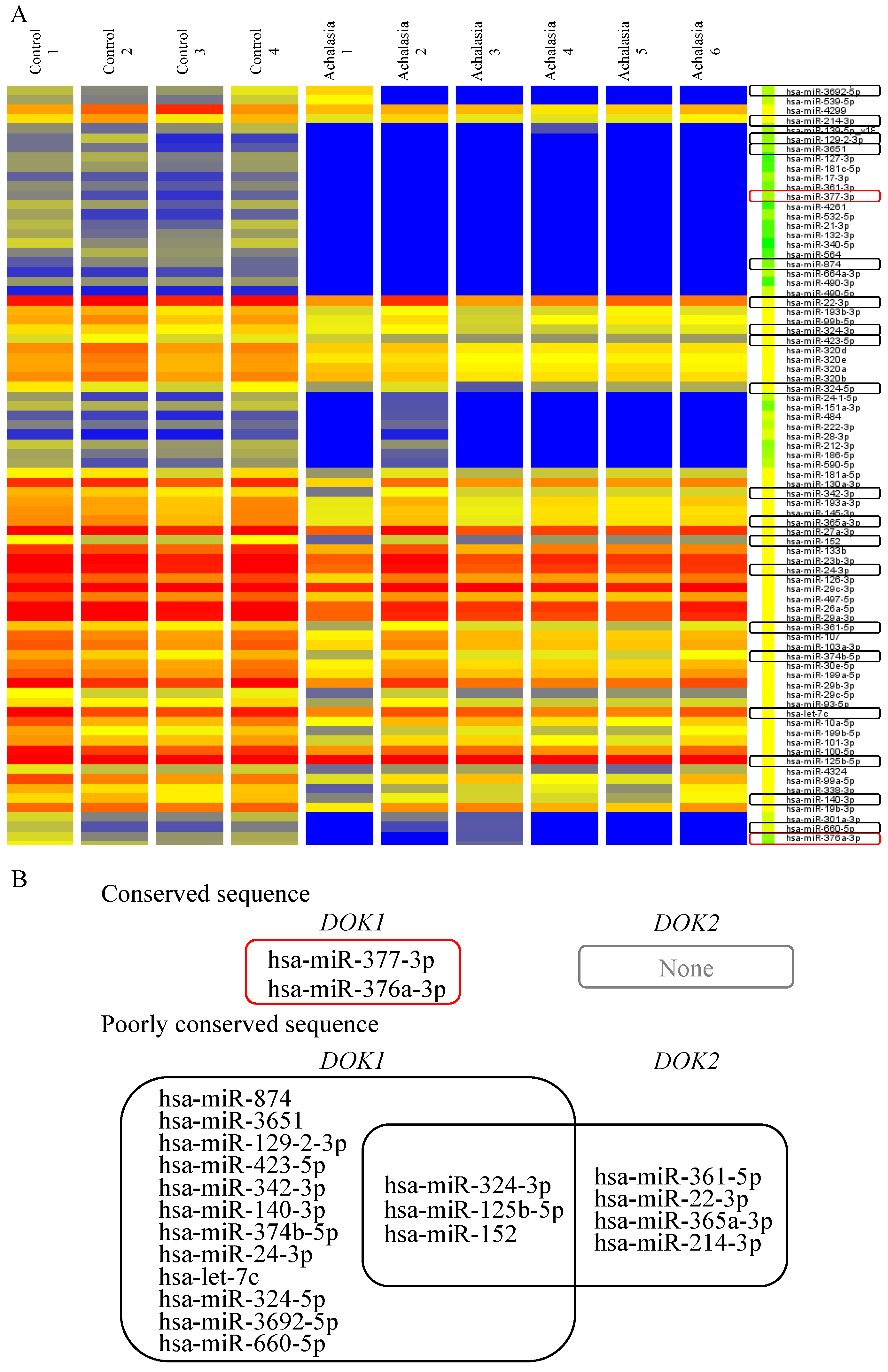
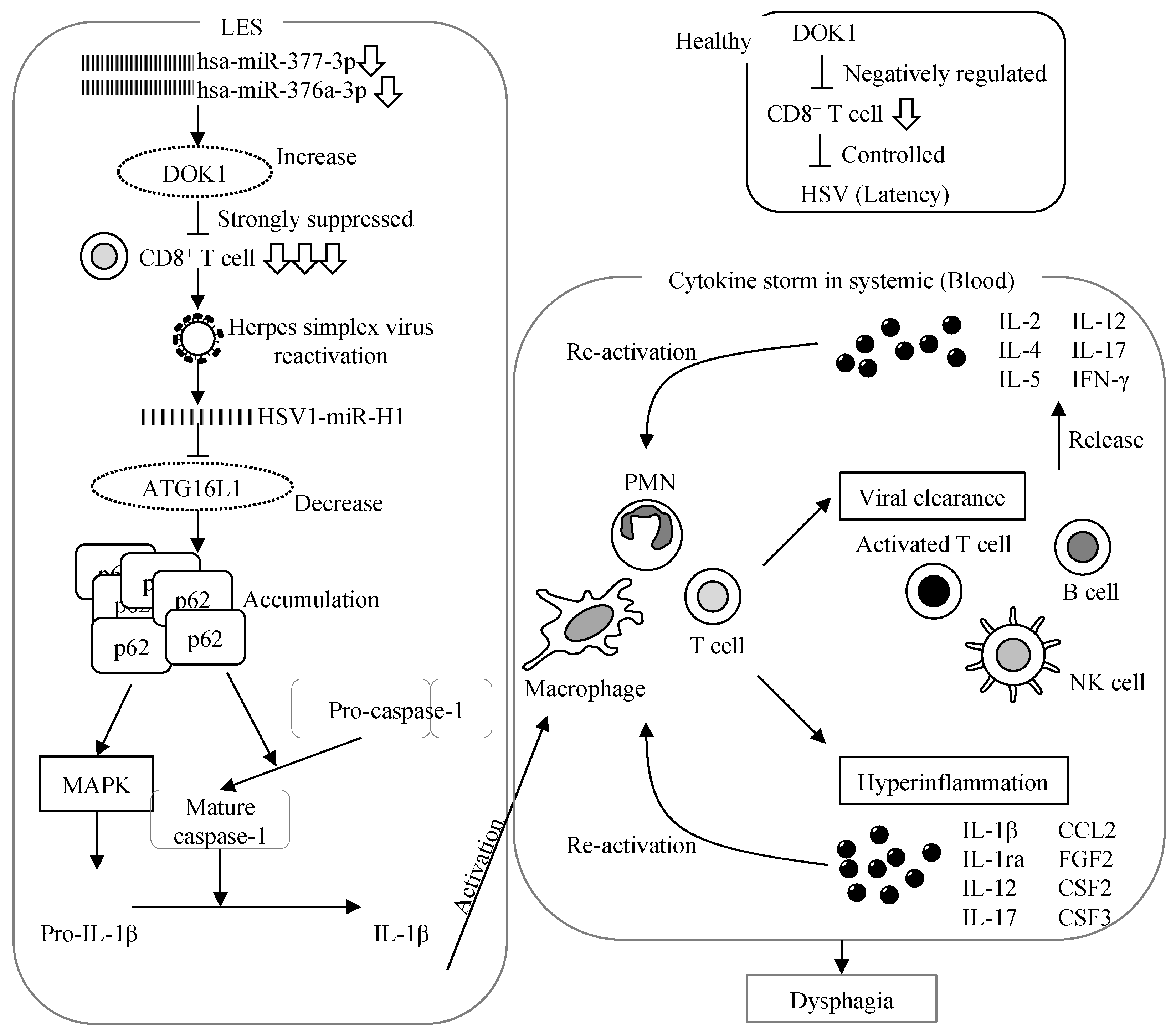
| Predicted Consequential Pairing of Target Region (Top) and miRNA (Bottom) | |
|---|---|
| Position 1172-1179 of DOK1 3′ UTR | 5′ …UUUAAGAAGUUUAUG-UGUGUGAA... |
| hsa-miR-377-3p | 3′ UGUUUUCAACGGAAACACACUA |
| Position 363-369 of DOK1 3′ UTR | 5′ …CCAAAGAGGAUCCCA-UCUAUGAU... |
| hsa-miR-376a-3p | 3′ UGCACCUAAAAGGAGAUACUA |
Disclaimer/Publisher’s Note: The statements, opinions and data contained in all publications are solely those of the individual author(s) and contributor(s) and not of MDPI and/or the editor(s). MDPI and/or the editor(s) disclaim responsibility for any injury to people or property resulting from any ideas, methods, instructions or products referred to in the content. |
© 2024 by the authors. Licensee MDPI, Basel, Switzerland. This article is an open access article distributed under the terms and conditions of the Creative Commons Attribution (CC BY) license (https://creativecommons.org/licenses/by/4.0/).
Share and Cite
Kanda, T.; Saiki, K.; Kurumi, H.; Yoshida, A.; Ikebuchi, Y.; Sakaguchi, T.; Urabe, S.; Minami, H.; Yamaguchi, N.; Nakao, K.; et al. Docking Proteins Upregulate IL-1β Expression in Lower Esophageal Sphincter Muscle in Esophageal Achalasia. J. Clin. Med. 2024, 13, 3004. https://doi.org/10.3390/jcm13103004
Kanda T, Saiki K, Kurumi H, Yoshida A, Ikebuchi Y, Sakaguchi T, Urabe S, Minami H, Yamaguchi N, Nakao K, et al. Docking Proteins Upregulate IL-1β Expression in Lower Esophageal Sphincter Muscle in Esophageal Achalasia. Journal of Clinical Medicine. 2024; 13(10):3004. https://doi.org/10.3390/jcm13103004
Chicago/Turabian StyleKanda, Tsutomu, Karen Saiki, Hiroki Kurumi, Akira Yoshida, Yuichiro Ikebuchi, Takuki Sakaguchi, Shigetoshi Urabe, Hitomi Minami, Naoyuki Yamaguchi, Kazuhiko Nakao, and et al. 2024. "Docking Proteins Upregulate IL-1β Expression in Lower Esophageal Sphincter Muscle in Esophageal Achalasia" Journal of Clinical Medicine 13, no. 10: 3004. https://doi.org/10.3390/jcm13103004
APA StyleKanda, T., Saiki, K., Kurumi, H., Yoshida, A., Ikebuchi, Y., Sakaguchi, T., Urabe, S., Minami, H., Yamaguchi, N., Nakao, K., Inoue, H., & Isomoto, H. (2024). Docking Proteins Upregulate IL-1β Expression in Lower Esophageal Sphincter Muscle in Esophageal Achalasia. Journal of Clinical Medicine, 13(10), 3004. https://doi.org/10.3390/jcm13103004







